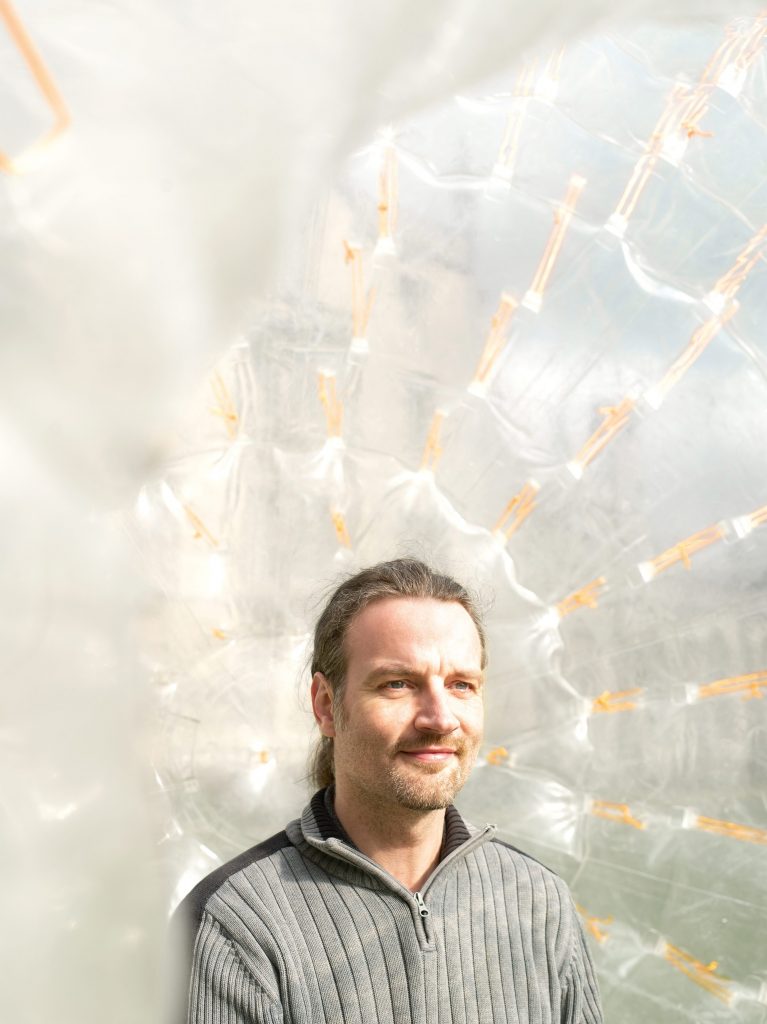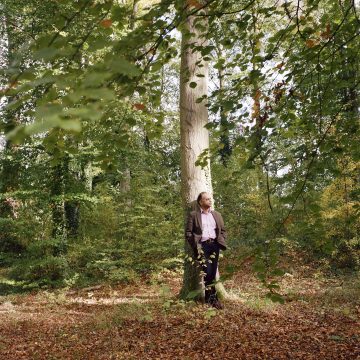Axons. Neurons. And Bruno.
Blue-sky science is high risk. You might find something amazing – or you might not – as Dr Kristian Franze has discovered.

So far, it has been a rather unconventional career. As a student, Dr Kristian Franze was torn between his love of physics and his love of animals. So when it came to deciding on a degree course, he flipped a coin – and veterinary medicine came up heads. Seven years on, Franze knew something was missing. Why did he still feel he wanted more of a challenge? Why did he hanker after something different? And why was he spending more time with the human owners of animals than with the animals themselves?
The result? A return to university for a PhD, initially in neuroscience and then in physics. But it wasn’t until his supervisor, Andreas Reichenbach, mentioned what he called ‘brain mechanics’ that something clicked. “Andreas had been trying to find someone brave (and naive?) enough to take the subject on for years!” Franze says. “He was clear that it would be high risk but high gain. We might not find anything interesting – but if we did, it would probably be big. And he was right.”
Brain mechanics
Today, Franze is a Reader in Neuronal Mechanics in the Department of Physiology, Development and Neuroscience, where visitors to his office in the Anatomy Building are greeted by Bruno, a bulldog skeleton. (Bruno is not the only sign that Franze has not entirely left animals behind: he has a little zoo at home and continues to teach veterinary students.) But what exactly is brain mechanics? Franze says that when he talks about ‘mechanics’, he means it literally – his work examines the role of forces, resistance, motion and fluids in the brain.
Papers discussing brain mechanics were being published as early as the late 19th century – but it is only recently that the technology has been available to investigate further.
This is not, as he points out, a new way of looking at the brain – indeed, papers discussing brain mechanics were being published as early as the late 19th century – but it is only recently that the technology has been available to investigate further. In 2020, neuroscientists are able to look beyond purely chemical signalling as a way of explaining how our brains work – and how we might repair them when they stop working.
Humans have billions of neurons (brain cells) and many more neuronal connections. If they don’t grow correctly, then the brain doesn’t work correctly, leading to neurodevelopmental disorders. So Franze’s focus is on axons: the protrusions of neurons that can be many metres long. Axons are vital because neurons use them to connect up with and send information to other cells. But if axons stop growing, grow in a wrong direction or don’t grow at all, there is no way to connect neurons properly. And if they are damaged – in a spinal cord injury, for example – nobody knows how to repair them. It’s an exciting problem, says Franze, because of its complexity, as well as the fact that no one has yet solved it.
“Most of what we know about how neurons know where to grow, when to stop growing and where to connect to is based on chemical signalling,” says Franze. “There are molecules in the tissue, so-called ‘guidance cues’, and neurons either grow towards them or away from them. That’s what we currently know. But, in the end, growth is motion, right? The cells have to move through the tissue. And motion is driven by forces and not by a molecule. If you wake up in the morning to the lovely smell of coffee, it’s attractive to you [and thus equivalent to a guidance cue]. But unless you get up and move your legs, exert force on your environment, you don’t get to the coffee.”
Similarly, he says, cells need to exert force in order to move – they need to interact mechanically with their environment. How effectively they move – and whether they move towards or away from that environment –depends both on the chemical and on the mechanical properties of the environment itself.
Brain stiffness
“We needed to develop a method that enabled us to measure brain tissue stiffness [the environment] in a living embryo,” he says. “And we needed to combine this with fluorescence microscopy, so that we could also see where the axons grow while we measure brain stiffness. Previous studies had looked at how you can change the function of a cell in response to substrate stiffness in a Petri dish, but not in a living animal.”
Frogs and humans aren’t so different. If we discover fundamental mechanisms in frogs, there is a good chance it can be applied to humans
It took eight years but, in 2016, Franze and collaborators published the first paper to demonstrate in vivo in frogs how manipulating brain tissue mechanics alters axon growth. “The frog is pretty robust,” he says. “And it’s very regenerative. You can take a piece of tissue in its brain, put it elsewhere and see how this changes what cells do. It’s also interesting to work with the frog because tadpoles regenerate their spinal cord: it regrows after you cut it. But after metamorphosis, that doesn’t happen any longer.” It’s also a well-studied part of the brain in this field, enabling the team to use a system where the chemistry is already well understood. If you already know the chemistry, you can focus on the mechanics, Franze says.
The response was “pleasantly positive”, he says. “If you introduce a new thought into a long-established field, you never know how it will go!” And this focus on mechanics has contributed to opening up a whole new field in neuroscience, one that is operating at the interface between physics, engineering, biology and medicine. Franze’s lab collaborates with the MRC Cambridge Stem Cell Institute, the CRUK Cambridge Centre and the John van Geest Centre for Brain Repair, to name but a few.
Blurring of the lines
My lab consists of biologists, physicists, engineers, a chemist, a vet – they come up with very different solutions and I learn from them all the time.
He relishes this blurring of the lines between the sciences. “Nobody can be an expert in everything. You can be good at one or two things, but that’s it. The key is to know your limitations and to find the right people to collaborate with. I have an amazing lab and all the success comes from my students, postdocs and technicians. My lab consists of biologists, physicists, engineers, a chemist, a vet – they come up with very different solutions and I learn from them all the time. We’re interested in scientific questions. We use the technology that’s available. And if nothing is available to address our questions or measure what we need, then we come up with a way to do it.”
Having demonstrated that mechanics are crucial to how the brain works, the next step will be figuring out how they intersect with chemistry. (Franze has just secured a European Research Council grant to investigate that relationship.) His lab is also pushing technology forward, with a recent paper on time-lapse stiffness mapping of living brain tissue, showing how it changes during development, and another one introducing artificial- intelligence-based software to automatically quantify dynamical processes in neurons and other cells. “In this field, when there is a very important question that hasn’t been solved for decades, there’s a good chance it can’t simply be answered just by chemistry or genetics, and that either appropriate technology is not available to address the question or people may have overlooked something,” says Franze.
As for the future, Franze says he’d love to put together a mathematical model that accurately predicts neuron growth patterns in the brain. That such a model currently doesn’t exist suggests something is missing, and that something could be the role of mechanics. And, of course, this blue-sky research could yet translate to humans: a life-changing possibility. But that’s not what gets him up in the morning, he says. Rather, he’s driven by curiosity.
Usually, when we find an answer, we come up with three new questions.
“I want to understand how this works just for the sake of it,” he says. “Frogs and humans aren’t so different in terms of the basic principles. If we discover any fundamental mechanisms in frogs, there’s a very good chance it can be applied to humans. Of course, if we have a chance to help people and have an impact on society, then we will use it.
“I don’t think you can always aim for a translational project from the beginning; your success is likely to be limited. If you want to change something on a big scale, my personal belief is that you have to understand fundamentally what’s going on first. I suspect I am not going to fully understand how things work in my lifetime. Usually, when we find an answer, we come up with three new questions. But I want to see how far I can get!”
Read more about neuroscience at Cambridge.







